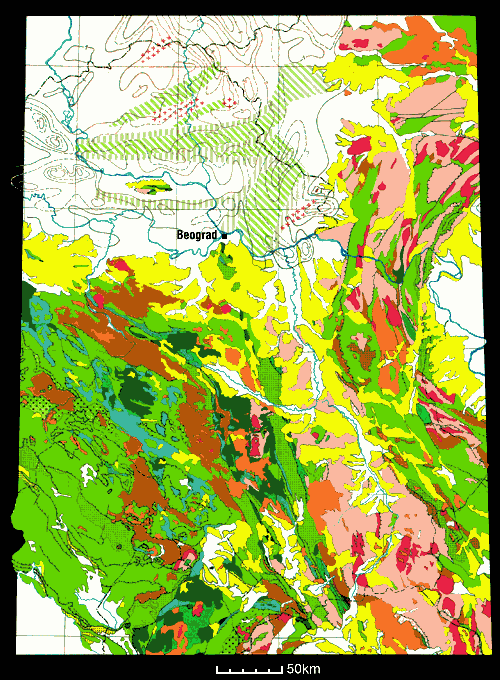|
THE DINARIDES
The Dalmatian-Herzegovinian Zone (formerly inadequately designated as the High
Karst Nappe) has been thurst over the Budva Zone. The direction and distance of movement
of this zone is still a matter of speculation. In the map area this zone is represented by
the Stara Crna Gora (Old Montenegro) Overthrust. The Middle Triassic resembles that found
in the Budva Zone. The Upper Triassic is characterized by a carbonate platform consisting
of shallow water carbonates whose deposition went on till the end of the Cretaceous and
terminated with Paleogene foraminiferal limestones. The Sarajevo Sigmoid, in the
map area known as the Kuci overthrust, is a conspicuous belt of mesozoic flysh. It
consists of thin Permian and Triassic clastics and neritic carbonates; next, of an
unconformable sequence of limestones that range from the Upper Jurassic to the Turonian,
and of transgressive Durmitor flysch of Senonian age, whose fold fabric is
characteristically intricate. Going NW, the composition of this belt becomes increasengly
complex, the onset of flysch sedimentation falling in the Jurassic. The East
Bosnian-Durmitor block represents a composite pile of nappes, the front of the
Durmitor nappe being its SW boundary.Below this nappe, consisting mainly of Paleozoic and
Triassic rocks, there is another nappe dominantly of Triassic sedimnets with volcanics,
revealed by tectonic windows near Berane. The tectonic windows in the latter display in
turn the Durmitor flysch whose displacements exceed 40 km. Numerous thin nappe sheets and
klippen can also be observed further NE showing that this area is built up of several
units differing in development. The Lower Triassic is mostly represented by sandstone. In
the Anisian, dolomites and bioclastic limestone with red Bulog limestone predominate,
while the volcanites close the sequence. The Ladinian generally starts with cherts and
tuffs, and is followed by comparatively thin cherty limestone, dolomite and reef
limestones. During the Upper Triassic a carbonate platform with a thick limestone sequence
developed in the SW of this area, while in the NE (Romanija and Jahorina Mts) only rather
thin Triassic-Jurassic cherty limestones were deposited. In the SW the Jurassic is mostly
represented by limestones, whereas in the NE it is built up of Ophiolitic Mélange, the
two kinds of rock being separated by a narrow flysch zone. The Cretacous is generally
absent. The Drina-Ivanjica Element is made up of a Paleozoic basement exibiting a
strong Hercynian tectogenesis with NE-SW trending axes; next, of a Triassic carbonate
platform the parts of which were gravitationally transported in the Ophiolitic Mélange
during the Upper Jurassic. These are followed by a shallow marine Upper Cretaceous in the
SW parts, and a transgressive Senonian sequence (rudite, rudist limestone, pre-flysch,
Kosovska Mitrovica flysch) along its boundary with the Vardar Zone.
THE OPHIOLITE BELT
separates the East Bosnian-Durmitor Block from the Drina-Ivanjica Element. It carries
large olilstoplaques of Triassic limestone gravitationally transported from the NE and E
(Devetak, Zlatibor, Zlatar, Giljeva, Mokra Gora, Zljeb); next, large masses of
ultramafites (Krivaja-Konjuh, Zlatibor), and blocks of oceanic crust (Dobrun) embedded in
the ophiolitic mélange and covering it. In its southern part this belt separates the
Dinarides from the Hellenides and is thrust over Mirdita.
|




